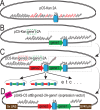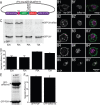Expression of multiple transgenes from a single construct using viral 2A peptides in Drosophila
- PMID: 24945148
- PMCID: PMC4063965
- DOI: 10.1371/journal.pone.0100637
Expression of multiple transgenes from a single construct using viral 2A peptides in Drosophila
Abstract
Expression of multiple reporter or effector transgenes in the same cell from a single construct is increasingly necessary in various experimental paradigms. The discovery of short, virus-derived peptide sequences that mediate a ribosome-skipping event enables generation of multiple separate peptide products from one mRNA. Here we describe methods and vectors to facilitate easy production of polycistronic-like sequences utilizing these 2A peptides tailored for expression in Drosophila both in vitro and in vivo. We tested the separation efficiency of different viral 2A peptides in cultured Drosophila cells and in vivo and found that the 2A peptides from porcine teschovirus-1 (P2A) and Thosea asigna virus (T2A) worked best. To demonstrate the utility of this approach, we used the P2A peptide to co-express the red fluorescent protein tdTomato and the genetically-encoded calcium indicator GCaMP5G in larval motorneurons. This technique enabled ratiometric calcium imaging with motion correction allowing us to record synaptic activity at the neuromuscular junction in an intact larval preparation through the cuticle. The tools presented here should greatly facilitate the generation of 2A peptide-mediated expression of multiple transgenes in Drosophila.
Conflict of interest statement
Figures




References
-
- Ryan MD, King AM, Thomas GP (1991) Cleavage of foot-and-mouth disease virus polyprotein is mediated by residues located within a 19 amino acid sequence. J Gen Virol 72 (Pt 11): 2727–2732. - PubMed
-
- Donnelly ML, Hughes LE, Luke G, Mendoza H, ten Dam E, et al. (2001) The 'cleavage' activities of foot-and-mouth disease virus 2A site-directed mutants and naturally occurring '2A-like' sequences. J Gen Virol 82: 1027–1041. - PubMed
-
- Szymczak AL, Workman CJ, Wang Y, Vignali KM, Dilioglou S, et al. (2004) Correction of multi-gene deficiency in vivo using a single 'self-cleaving' 2A peptide-based retroviral vector. Nat Biotechnol 22: 589–594. - PubMed
Publication types
MeSH terms
Substances
Grants and funding
LinkOut - more resources
Full Text Sources
Other Literature Sources
Molecular Biology Databases
Research Materials

